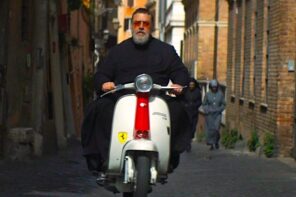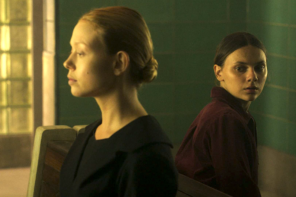In 2002, Catholic theologian Christine Gudorf predicted that “within a generation or two,” Catholic hierarchical teaching will change to encourage contraception in marriage and to allow some abortions, noting that “this change has already occurred among Catholic theologians.”
“The hierarchy will follow because as they confront the reality of a biosphere gasping for survival around its teeming human inhabitants,” they will honor the choices of those who opt for “artificial contraception and early abortion.”
Her prediction startled some, but there has been movement. Last year the conservative Pope Benedict XVI clumsily but clearly allowed the use of condoms to prevent HIV/AIDS; something that bishops in AIDS-ravaged parts of Africa had already been putting into practice.
Commonweal, a Catholic magazine with a mostly conservative stance on abortion, has thrown its hat into the ring, publishing a trio of essays entitled “Can We Talk About Abortion?” The three scholars, Dennis O’Brien, Peter Steinfels, and Cathleen Kaveny, hew closely to hierarchical teaching, which they identify tout court as “the Catholic teaching.” So, is this glacier moving?
The Hierarchy is Only One Source of Truth
The authors do sense the need to move from taboo to nuance on abortion, and maybe someday take steps toward the future that Gudorf has predicted. Yet, while they do share the feeling that something is amiss, only one, Dennis O’Brien, dares to take a step outside of the door, which he does cautiously, and with nervous glances backwards. He agrees with the late, esteemed Jesuit Richard McCormick that abortion is “morally problematic”—which is quite an admission since it’s not problematic for the bishops or the Pope, for whom abortion is dead wrong and “an unspeakable crime.” Still, O’Brien parts company with these absolutist hierarchs, a position that’s anything but rash since none of the bishops are professional theologians (even if they play at it in the press).
Catholic teaching says there are three possible sources of truth, the hierarchy being only one. The other two are the sensus fidelium (the experience-fed wisdom of the laity) and what Cardinal Avery Dulles, following St. Thomas Aquinas, called “the magisterium of the theologians.” Historically, each has erred, and each has led the way in the quest for moral truth. History does not bless—and indeed laughs at—the claim that any one of them is infallible. Small wonder Cardinal Dulles wisely said:
We shall insist on the right, where we think it important for the good of the Church, to urge positions at variance with those that are presently official.
Dennis O’Brien is “at variance” with the Second Vatican Council’s view that every abortion is an “unspeakable crime.” And so are most Catholics. In this they are joined by authorities in all the world’s religions.
O’Brien notes that in 2006, the Catholic Diocese of Sioux Falls “strongly” supported HB 1215 permitting abortion, “to prevent the death of a pregnant mother.” In other words those abortions would not be “unspeakable crimes.” If they were, you could not do evil to accomplish good (a hallowed Catholic axiom), even to save the “pregnant woman.” Sioux Falls was not at one with Rome there. That’s movement.
O’Brien is a little short on specific cases, which departs from Catholic “casuistry” which insisted on testing theory with real-life cases in order to anchor theory in reality. He does allow abortion if there is “a serious threat” to the woman’s health or if the pregnancy results from rape—exceptions that the Pope would not allow. But even here, O’Brien steps back, saying that a saintly rape victim might be holy enough to bear the rapist’s baby and extend her victimization. Come, come! That not only gives sanctity a bad name, but it also besmirches the moral judgment of rape victims who choose abortion, implying that they might not do it if they were a little more saintly.
Sympathy for the Bishops
The second essay is by Peter Steinfels, former religion editor at the New York Times. Steinfels, who is hard right on abortion, has “more sympathy for the bishops,” which is an understatement. Brandishing hierarchical texts, Steinfels excoriates O’Brien for challenging “Catholic teaching at its root.”
And there’s the rub.
In place of the tripod of hierarchy, theologians, and sensus fidelism—which allows for mutual ongoing correction—Steinfels offers only the monopod of hierarchy. A trip through history to watch popes do such things as claim total authority over civil governments and deny the right to religious freedom would be chastening. (A read of John Julius Norwich’s Absolute Monarchs: A History of the Papacy would likewise tame even the most extreme papal fever.)
Steinfels faults O’Brien for his “minimization of the moral status of the unborn but developing human lives”—i.e. fetuses. Fetuses have moral status but their value does not trump all other values. Giving fetuses absolute value effectively divinizes them. This position is symbolized by anti-choice demonstrators who depict the fetus on a cross like Jesus. This removes the fetus from the necessary interplay of competing values that marks all ethical discourse. It’s also a form of idolatry.
If you can end a fetus’ life, Steinfels argues, why not kill “newborns, the severely mentally disabled, the comatose, demented, or dying.” Come, come! If you can make distinctions where there are differences, which is the hallmark of clear thought and sanity, you can judge different issues differently. Thomas Aquinas put it simply: “Human actions are right or wrong according to the circumstances.” If the circumstances are different, your moral judgment can be different. And the circumstances of all the cases Steinfels hauls out from his store of non sequiturs are really and crucially different. A judgment on one does not lock you into the same judgment on the others.
He is, however, right in calling for more cases where abortion is an issue. Perhaps I can help by offering some and ask whether he considers the women who made these choices moral criminals who have committed an “unspeakable crime”:
- A woman is two months into a happy pregnancy. She is diagnosed with cancer requiring immediate chemotherapy which also attacks the fetus. She aborts.
- In spite of her best contraceptive efforts a woman gets pregnant. She has a heart condition, which would put her at high risk of dying if she stays pregnant. She aborts.
- Rosita, a nine-year-old Nicaraguan girl is raped and impregnated. She cannot bear a child at her age without potentially disastrous effects on her body and mind. An abortion is arranged.
- A case was once brought to the attention of Fr. Bernard Haring, the distinguished Redemptorist Moral Theologian. After removing a tumor from the uterus of a pregnant woman, a surgeon in Germany could not stop the bleeding. He removed the non-viable fetus so that the uterus would contract. It did and the woman survived. A priest told the surgeon, who was Catholic, that he had acted wrongly. The surgeon appealed to Fr. Haring who disagreed, contending that the surgeon acted morally and properly as he had saved as much life as was possible. Fr. Haring asked: by what thinking could the fetus have such a right to life that it could kill both itself and the woman by exercising it? Such rights, he said, do not exist.
- Alicja Tysiac, in 2000, was advised that her pregnancy, if it went to term, would cause blindness. She was forbidden to abort and lost nearly all her eyesight. The European Court of Human Rights ruled in her favor saying she should have been allowed to abort.
- In 2005, the UN Human Rights Committee ruled that Peru had violated the rights of a 17-year-old girl who was forced to carry to term an anencephalitic fetus, missing most of its forebrain, and unable to survive outside the womb. The International Covenant on Civil and Political rights ordered Peru to pay reparations and establish a framework for women to access therapeutic abortions.
- In 2006, the Inter-American Commission on Human Rights made Mexico pay $40,000 to a 13-year-old rape victim who had been forced to give birth, plus a stipend for her son’s education.
Few ethicists in any of the world’s religion would argue that abortions performed or contemplated in these cases are immoral. Recognizing complexity is the beginning of wisdom on abortion or any other moral issue. I commend that recognition to all three of these Commonweal authors.
Women Have the Moral Agency of a Minor
Cathleen Kaveny, who teaches law and theology at the University of Notre Dame, offers no defense of any abortion. She concedes that most Americans do not want to prohibit abortion legally and that one out of three American women will have an abortion. More importantly she notes that “the death rate among women who procure abortions is much higher when the procedure is illegal.” But Kaveny commits, to use a Catholic term, a mortal sin from which she must repent. She does not want to punish women who have abortions. That’s fine. But she joins those who see women who have abortions as “abortion’s second victims.”
To support her case for not punishing women who had abortions, she offers a wild analogy. “We do not, after all, arrest minors for conspiracy to commit statutory rape, even if they consented to the sexual act in question.”
Ouch!
A mature woman who chooses an abortion for serious moral reasons is comparable to an imprudent adolescent? And this woman is also a “victim,” not a mature moral agent?
The three authors may want to take a trip to Florence, Italy, where, in the Church of San Marco, they might pay homage at the tomb of St. Antoninus, the Dominican former Archbishop of Florence. Antoninus was the premier moral theologian on the subject of sex and marriage. He approved of early abortions when necessary to save the life of the woman—a large category in the medical and hygienic conditions of his day. Far from having been condemned he was canonized a saint in 1523. His feast day is on May 10.
I would like to raise funds to make 3,000 statues of St. Antoninus to send to all the world’s Catholic bishops, with an extra large one for the Pope. And I would ask them, before pontificating on abortion, to kneel and say a prayer to their saintly, pro-choice predecessor. It could be very helpful.




